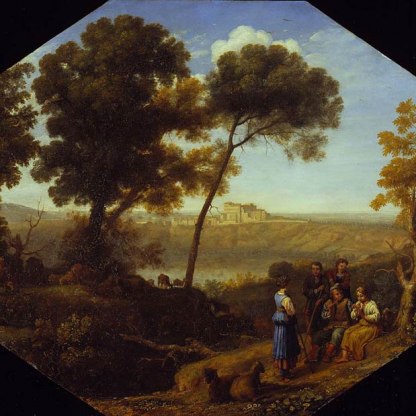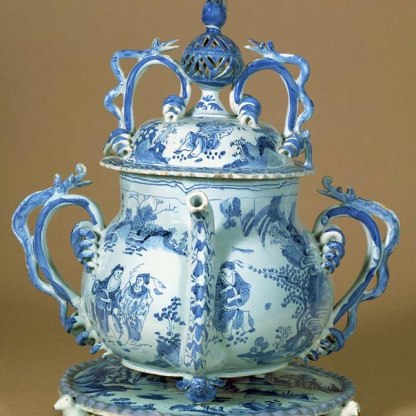Poplars

For me a landscape hardly exists at all as a landscape, because its appearance is constantly changing; but it lives by virtue of its surroundings, the air and the light which vary continually.
Claude Monet
In the 1890s, Claude Monet undertook several series of paintings, multiple studies of a single subject viewed under different weather conditions and at different times of day. It was part of his lifelong project to capture in paint the transitory appearance of nature, the shifting perceptions of an environment caused by changes in light, weather, movement. It was an aim that in the 1870s had exposed Monet and his fellow Impressionists to riducule and criticism, but one that by the 1890s had altered the course of French art forever.
In 1891 the owners of a group of poplars near Monet's home in Giverny decided to auction off the fully-grown trees. They had been planted in the first place for commercial rather than aesthetic reasons, and had always been destined to be turned into matchsticks or scaffolding. But the trees had captured Monet's imagination and at the sale he came to an arrangement with their buyer, to ensure that they would not be felled before he had had a chance to paint them at his leisure. Between spring and autumn of 1891 he worked on twenty-three canvases of the poplars, fifteen of which eventually formed a successful exhibition at the gallery of the dealer Paul Durand-Ruel in Paris the following year.
Monet painted all these studies en plein air (out of doors), working them up later in his studio if necessary. The poplars had been planted at regular intervals along the banks of river Epte, and Monet painted many of his studies from aboard a flat-bottomed, partially covered barge, on which he could set up several easels at once. In a work, left, painted in 1874 by his mentor and friend Édouard Manet, we see the young Monet sitting before his easel in his floating studio. This painting is now in the Neue Pinakothek, Munich.
In the superbly preserved Fitzwilliam painting there is no water visible, although the meander of the river is suggested by the 'S' pattern that the poplars describe along its bank. We see them from a very low viewpoint, and the four trees in the foreground soar skywards above us, slim yet towering.
The blue-green tree-tops, appearing as an indistinct blur on the horizon, zig-zag their way rhythmically across and up the canvas, gaining in clarity and size until they reach a crescendo in the top left. One thinks of a sound getting louder: a whisper, becoming a murmur, becoming a whoosh. There seems also to be the sense of a faint breeze rippling the foliage.
In terms of colour, the overwhelming impression is of green and varying shades of blue. But Monet has used reddish brown on the tree trunks and yellow in the foreground, to give depth and texture. The use of colour as a structural element in painting was a hallmark of the Impressionist technique. Monet once advised a young painter:
When you go out to paint, try to forget what objects you have before you – a tree, a house, a field, or whatever. Merely think, here is a little square of blue, here an oblong of pink, here a streak of yellow, and paint it just as it looks to you, the exact colour and shape, until it gives your own naïve impression of the scene before you.
In his bold use of colour, and indeed in the subject-matter here, Monet was influenced by Japanese woodblock prints, which had become popular in France in the preceding decades. For example, a work by Utagawa Hiroshige (1797–1858) in the Fitzwilliam, entitled Numazu ('Twilight'), it shows travellers walking along the tree lined banks of the Kise river in Japan.
In addition to the decorative qualities of Monet's painting, and its fascinating evocation of light, of weather and of nature, the trees themselves have a contemporary symbolic significance. The poplar had been, since the time of the Revolution of 1789, the 'Tree of Liberty' for the French, and, in the wake of the Franco-Prussian war of 1870–1, this symbolism was revived. In Poplars, therefore, Monet, the foremost French painter of his day, is celebrating his nation's independence as much as its landscape.
Themes and periods
Data from our collections database
The artist's studio, with Gimpel Fils, 1950 from whom bought by Captain Sykes
Legal notes
Captain S.W. Sykes, O.B.E., M.C.
Acquisition and important dates
- Method of acquisition: Bequeathed
- Dates: 1966
Dating
- 19th Century, Late
- Production date: AD 1891
Maker(s)
- Monet, Claude Painter
Place(s) associated
- Giverny
Materials used in production
Read more about this recordOther highlight objects you might like
Suggested Curating Cambridge products
Poplars by Monet - Silk tie
£45.00

Monet's Poplars - Art print
£30.00

Sign up to our emails
Be the first to hear about our news, exhibitions, events and more…



